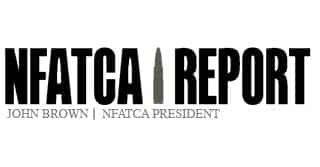JEFF FOLLODER | NFATCA EXECUTIVE DIRECTOR
The opportunities offered to firearms enthusiasts under the National Firearms Act (NFA) legislation and regulation are varied and numerous. Most every permutation has been brought forth, and there is an awful lot of fun and utility that has been created under the NFA. So, it is with a bit of a smile that we review something new(ish) and the proper way to deal with it under the aegis of the NFA.
Savage’s 42 Takedown neatly breaks down into two major components for easy transport and sports a combination barrel with a 20-inch .22LR barrel and a 20-inch .410 shotgun barrel. Many of you may remember similar “combination” guns from the past under various names, such as “Snake Charmer,” “M6 Survival Rifle,” etc. Of course, with the surging popularity of NFA in today’s firearms arena, less is more. Many people absolutely wanted to make this weapon even more convenient by shortening both barrels. The question became one of exactly how to register such a weapon. Is it a short-barreled rifle (SBR)? Is it a short-barreled shotgun (SBS)? Is it both? Because ATF’s eForms system will allow registration of a weapon in simultaneous categories, we sought clarification.
A weapon with rifled and smooth bore barrels under 16 and 18 inches, respectively, that are simultaneously part of the firearm, even when shooting only one of the barrels at a time, is considered one NFA firearm that requires only one registration. This registration can be either an SBR, or an SBS depending if only one barrel is shortened, or as an “Any Other Weapon” (AOW) if both barrels are shortened and it meets the length requirements of an AOW. This is what most owners would choose. It need not be both because ATF taxes only once when a single weapon integrates more than one feature, either of which would bring the firearm under the purview of the NFA, and there is a special definition in AOW: “Weapons with combination shotgun and rifle barrels 12 inches or more, less than 18 inches in length, from which only a single discharge can be made from either barrel without manual reloading.” For an example of a single tax combination of two NFA categories, a machine gun with an integral silencer could incur a single transfer tax if the suppressor could not be removed. Transfer of a machine gun with a removable silencer would incur a tax for each item.

So far, so good. But what about one of the most popular long arms available on the civilian market, the AR-15 and all of its permutations? Most are aware of the avalanche of caliber and barrel length choices for this modern sporting rifle. Most are unaware that it is now possible to acquire a shotgun upper that will mate with and function with the standard lower. Most commercial offerings feature barrel lengths of 18 inches or more. Fun and useful? Certainly. But it could be so much more so if you shortened the barrel to, say, 10.5 inches, right? Would proper registration of such a “dual purpose” weapon be the same as the Savage 42 Takedown? Not so fast.
If the weapon is such that the rifled and smooth bores under 16 and 18 inches, respectively, are used at different times by replacing one with the other, two NFA registrations are necessary. Put another way, if a registrant wants to have an AR-15 with a short-barreled smooth bore upper and a short-barreled rifled upper, they need to register both. A search of the National Firearms Registration and Transfer Record (NFRTR) will indeed show a double registry on a single serial number, but this is appropriate because these are two different “firearms” under the NFA; although they happen to share a receiver. NFA correctly states that there is no “receiver of an SBR or SBS.” The weapon itself is registered, not the receiver. The ATF will impose $200 in taxes in the permanent configuration and $400 in taxes in the modular configuration.
Frankly, the existence of short-barreled long arms as part of the NFA (along with suppressors) has long outlived its usefulness. These items should not be regulated under the NFA and should be removed from its purview. Unfortunately, we are acutely aware that Congress really doesn’t understand firearms, is prone to inaction and only promulgates new restrictions based upon emotion instead of facts. With that said, we feel it is important for the firearms community to understand the right way to do things under existing regulation. The NFATCA has been helping this community find its way through the thicket for almost 15 years. We’re happy to help, whenever we can. Have a question? Drop us a note at info@nfatca.org. And please don’t forget to sign up or renew your membership online at nfatca.org.
| This article first appeared in Small Arms Review V24N7 (Aug/Sep 2020) |












